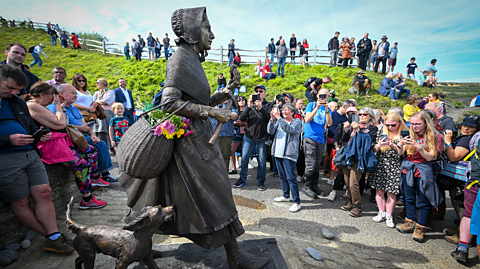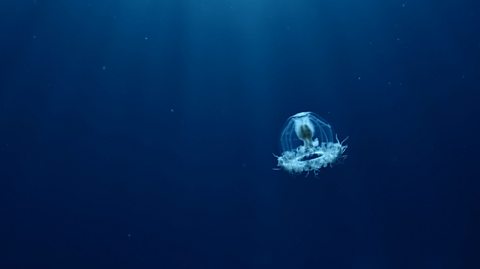The calculations behind the first American astronaut in space, the unearthing of the first complete fossil of a dinosaur, and the discovery of greenhouse gasses. What do these achievements have in common?
Thatâs right. They are all achievements first made by women. Women and girls across the world have long fought for representation and equality in the scientific field. While some female scientists, such as Marie Curie, have since become household names, others remain lesser known.
±«Óătv Bitesize takes a look at the women behind the remarkable science that has shaped how we look at the world today.

Katherine Johnson: Helped send the first American astronaut into space
Katherine Johnson is recognised as a key figure in the United States of Americaâs space history. Her genius was discovered at a young age. She attended high school at 10 years old and graduated with a bachelorâs degree in Mathematics and French eight years later. In 1939, she was one of the first three African American students selected to enrol in a graduate program at West Virginia University.
Johnsonâs life changed forever when she joined NACA, later called NASA, as a âcomputerâ. In the 1950s, there were no computers like today, so people had to solve complex maths problems themselves.
During this time, she was instrumental in calculating trajectories, launching window opportunities and creating emergency return paths for spacecrafts during the Space Race. As a result of Johnsonâs intricate manual calculations and pioneering use of computers, NASA was able to fly Alan B. Shepard Jr, the first U.S. astronaut, into space and Earthâs orbit in 1961, as well as sending the 1969 Apollo 11 flight to the moon.
Johnson has since been the recipient of the Presidential Medal of Freedom and in 2016 NASA named a building, the Katherine G. Johnson Computational Research Facility, after her. That same year 20th Century Studios released Hidden Figures, a biographical film that dramatised her time at the space agency.

Eunice Newton Foote: Discovered the existence of greenhouse gases
Scientist, inventor and womenâs rights campaigner, Eunice Newton Foote achieved a lot in her lifetime, but it wasnât truly acknowledged until the 21st Century.
Newton Foote was born to parents Theriza Newton and Isaac Newton Jr, a distant relative of the famous mathematician and physicist. As an amateur scientist in the mid-1800s, Newton Foote discovered the existence of greenhouse gases and their potential to affect change in climate.
She unearthed this while conducting experiments that compared the temperatures within cylinders filled with different gases. The results of this showed that Water in the form of a gas, resulting from heating water or ice. and carbon dioxide had the ability to raise temperatures.
From this, Newton Foote made the ground-breaking hypothesis that Earth would be substantially warmer if carbon dioxide levels were higher, and thus discovered the greenhouse effect.
While her work was presented at an 1856 American Association for the Advancement of Science meeting, it was done so by a male colleague of hers.
It wasnât until a geologist accidentally rediscovered her work in 2011, that this climate science pioneer became known to the public.

Mary Anning: Unearthed the some of the first complete dinosaur skeletons
Ever wondered why the coastline stretching across Dorset and Devon is referred to as the Jurassic Coast? It might have something to do with Mary Anning, a palaeontologist and fossil collector from Lyme Regis.
Anning was born into a poor family in 1799, and her family members relied on the sale of âcuriositiesâ, which she later learnt were fossils. She and her family would collect them from along the English Channel in order to make a living.
At the age of 12, she discovered an ancient reptile called an ichthyosaur, meaning âfish lizardâ. Later in life she also found a long-necked marine reptile called a plesiosaur.
When Anning was alive only men were permitted to publish work in the scientific community, but this didnât stop her from documenting her findings to improve her understanding of the dinosaur fossils she found.
Her most renowned find happened in 1824, when she discovered and excavated the first ever intact A type of primitive flying reptile from the Early Jurassic Period, approximately 200 million to 176 million years ago. skeleton.
Anningâs legacy has not been forgotten and she is recognised for some of the most significant geological discoveries of all time.
Her contribution shed light on and led to new ideas about the history of the Earth and now, thousand of tourists visit Lyme Regis to search the beach for fossils each year, just as Anning did.
This article was published February 2023
From flying frogs to the purrr-fect cuppa: Unusual research studies that will blow your mind
±«Óătv Bitesize takes a look at some curious Ig Nobel Prize winning research studies.

Three 'immortal' creatures that have fascinated scientists for decades
These animals seem to have cracked the code to stop, or even revert, ageing.

The stories behind todayâs routine medical procedures
Anaesthetics, blood transfusions, cardiac surgery - they all started somewhere.
